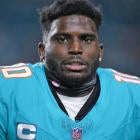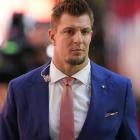
The New York Jets are embarking on a new era under head coach Robert Saleh. They made some moves in free agency to shore up weaknesses in the playmaking and pass-rushing departments, but there is still plenty of work to do once the draft rolls around.
The Jets are widely expected to take a quarterback with the No. 2 overall pick in the NFL Draft, but they have eight more selections after that, which could be used to fill a wide variety of needs, of which there are plenty to address. Here's one stab at how the Jets' entire 2021 draft will play out:
| Round (Pick) | Prospect | College |
|---|---|---|
| 1 (2) | QB Zach Wilson | BYU |
| 1 (23) | OL Alijah Vera-Tucker | USC |
| 2 (34) | WR Rashod Bateman | Minnesota |
| 3 (66) | S Jamar Johnson | Indiana |
| 3 (86) | CB Thomas Graham Jr. | Oregon |
| 4 (107) | OT Brady Christensen | BYU |
| 4 (113)* | CB Ambry Thomas | Michigan |
| 5 (146) | LB Justin Hillard | Ohio State |
| 5 (154) | RB Pooka Williams Jr. | Kansas |
| 6 (186) | EDGE Janarius Robinson | Florida State |
Note: In this scenario, the Jets trade Sam Darnold to the Carolina Panthers for a fourth-round pick, No. 113 overall.
Here's where you can purchase an officially licensed Jets NFL Draft hat and other Jets merchandise, some at 65% off.
While you can agree or disagree with the idea of Zach Wilson being the second-best quarterback in this draft class, all signs are pointing toward the Jets drafting him at No. 2 overall, so we started from there in order to make this mock draft as realistic as possible. Wilson's skill set is a good fit for new offensive coordinator Mike LaFleur's offense, with his mobility and on-the-move passing capabilities setting him up well to run the play-action, boot-heavy concepts that form the basis of the system. Wilson's accuracy on intermediate throws makes for a strong fit with new wideout Corey Davis, while his willingness to let it rip downfield should pair well with perimeter deep threat Denzel Mims.
The Jets got their left tackle of the future last year in Mekhi Becton, but they still have needs along the offensive line. Wilson was extremely well-protected at BYU to the point that we can't even necessarily be sure about how he'll handle pressure at the NFL level. Even if that weren't the case, the Jets would still be wise to invest more resources into his protection unit. Vera-Tucker, then, makes for an excellent selection, with his versatility to play either guard or tackle, both of which he did in college at USC.
New York has two receivers that make sense in its system already, but adding Bateman early in the second round would give the Jets an extremely enviable trio and put them way ahead of the curve when it comes to creating a sound infrastructure for their new quarterback. Bateman's speed (he ran the 40-yard dash in 4.39 seconds at the EXOS combine), frame, and route-running make him an excellent fit as a slot receiver, though he has the ability to do more than just work on the inside. Drafting him would allow the Jets to cut ties with Jamison Crowder and save more than $10 million against the cap.
After spending the first three picks on offense, the Jets get to work addressing their secondary, which is a major area of weakness. Johnson makes for an excellent fit alongside incumbent free safety Marcus Maye, with his ability to play in or around the box, and particularly against the run. He's also a terrific athlete and makes for a strong fit in Robert Saleh's zone-coverage schemes, which require his safeties to be able to play either a deep half or one of the deep or intermediate zones when they shift to single-high looks.
Graham opted out of the 2020 season and has gone a bit overlooked, but his ball production (eight interceptions) and ability to play press and/or zone coverage would make him a nice Day Two fit for the Jets. He has good size and length and is extremely competitive at the point of the catch, traits that are necessary for a Saleh corner. He's not the fastest cornerback you'll ever see, but the defense Saleh runs doesn't necessarily require top-end speed from a cornerback because they tend to play on top of routes as opposed to underneath them. Thomas, like Graham, opted out of the 2020 season, but he has some similar traits, in terms of his ability to play up close to the line of scrimmage and/or work in zone coverages. His best attribute is probably his physicality which, again, makes him a strong fit for Saleh's scheme.
Adding Christensen would not only give the Jets another option along the offensive line, but also give Wilson one of his former collegiate teammates among that unit. Christensen played left tackle at BYU but seems like a pretty good projection on the right side, but could also work as the team's swing tackle early in his career unless and until he is ready to step into the starting lineup.
Hilliard was a part-time player at Ohio State, but he's a good fit as a SAM linebacker in a 4-3 defensive scheme. He may not be the most able linebacker in pass coverage but if you're looking for someone to come down and hit in the run game and/or disrupt tight ends off the line of scrimmage when they go out on pass routes, he can fill that role, as well as contribute on special teams.
Williams only played four games in 2020, but what he showed in 2018 and 2019 is enough to merit consideration with a Day Three pick. He's an extremely decisive runner with excellent speed, making him exactly the kind of back that has excelled in LaFleur's Shanahan-style offense. Williams also showed versatility in the passing game, catching 60 passes for 503 yards and four scores during his first two seasons at KU. He may not be the type of player you can give 25 carries a game, but those players are rare these days. His skill set works very well in a backfield timeshare.
Robinson was a three-year starter at FSU and has the versatility to play in either a 4-3 or 3-4 defense. His size and ability to set the edge are already there, but if you can tap into his considerable physical gifts, he can become even better as a pass rusher. It may not happen right away, but there's enough upside to make it worth a shot.


















